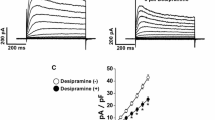Abstract.
Fluoxetine is a widely used antidepressant compound having selective serotonin reuptake inhibitor properties. In this study, the actions of fluoxetine were analyzed in guinea pig, rat, rabbit and canine ventricular myocardiac preparations using conventional microelectrode and whole cell voltage clamp techniques. Low concentrations of fluoxetine (1–10 µmol/l) caused significant shortening of action potential duration (APD) and depression of the plateau potential in guinea pig and rabbit papillary muscles and single canine ventricular myocytes. In rat papillary muscle, APD was not affected by fluoxetine (up to 100 µmol/l), however, the drug decreased the force of contraction with EC50 of 10 µmol/l. Fluoxetine (10 µmol/l) also decreased the maximum velocity of depolarization and action potential overshoot in each species studied. At this concentration no effect was observed on the resting membrane potential; high concentration (100 µmol/l), however, caused depolarization.
In voltage clamped canine ventricular myocytes, fluoxetine caused concentration-dependent block of the peak Ca2+ current at 0 mV with EC50 of 5.4±0.94 µmol/l and Hill coefficient of 1.1±0.14 (n=6). In addition, 10 µmol/l fluoxetine shifted the midpoint of the steady-state inactivation curve of the Ca2+ current from –20.7±0.65 to –26.7±1 mV (P<0.001, n=8) without changing its slope factor. These effects of fluoxetine developed rapidly and were fully reversible. Fluoxetine did not alter voltage-dependence of activation or time constant for inactivation of ICa. Fluoxetine had no effect on the amplitude of K+ currents (IK1 and Ito). The inhibition of cardiac Ca2+ and Na+ channels by fluoxetine may explain most cardiac side effects observed occasionally with the drug. Our results suggest that fluoxetine may have antiarrhythmic (class I + IV type), as well as proarrhythmic properties (due to impairment of atrioventricular or intraventricular conduction and shortening of repolarization). Therefore, in depressed patients with cardiac disorders, ECG control may be suggested during fluoxetine therapy.
Similar content being viewed by others
Author information
Authors and Affiliations
Additional information
Electronic Publication
Rights and permissions
About this article
Cite this article
Pacher, P., Magyar, J., Szigligeti, P. et al. Electrophysiological effects of fluoxetine in mammalian cardiac tissues. Naunyn-Schmiedeberg's Arch Pharmacol 361, 67–73 (2000). https://doi.org/10.1007/s002109900154
Received:
Accepted:
Issue Date:
DOI: https://doi.org/10.1007/s002109900154




